
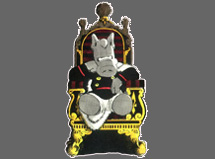
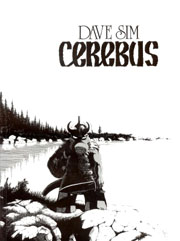
Welcome to Estarcion, the wildly absurd and funny world of Cerebus the Aardvark. This initial volume collects the first two years of stories from Dave Sim's 300-issue magnum opus. Don't be discouraged by the initially crude artwork or the silliness of the stories. It gets better--even noticeably within this volume. This first installment is the most valuable in preparing for the larger stories ahead.
When we first meet Cerebus--a small, gray, and chronically ill-tempered
aardvark--he is making his living as a barbarian. In 1977, when the Cerebus
comic book series began, Sim initially conceived of it as a parody of
such popular series as Conan, Red Sonja, and Elric but quickly mined that
material and transformed the scope of the series into much more. Even
by the end of this volume, the Cerebus story begins to transform beyond
"funny animal" humor into something much more complex and interesting.
High points in Cerebus
include the introduction of Lord Julius, the dictator of Palnu, who looks,
acts, and talks just like a certain cigar-smoking, mustachioed comedian;
Jaka, Cerebus's one true love; Elrod the Albino, an inept swordsman; and
the Cockroach, the-mother-of-all-superhero-parodies and "inspiration"
for the much-later TV and comic character--the Tick. All of these characters
appear later on in the series as part of a constantly present ensemble
of supporting figures.

High Society is the
beginning of the main Cerebus story line and one of the finest graphic
novels ever published. The artwork is much improved and the level of humor
reaches its high point in the series to date. Parliamentary politics were
never so much fun as they are in the Prime Minister election of 1414.
Lord Julius and the mysterious Astoria battle for control of the city-state
Iest with Cerebus as their unwitting pawn. Goats, bunny sketches, the
Regency Elf, and Moon Roach join the pandemonium, helping to set the stage
for things to come.

A face from Cerebus's past returns with an offer he can't refuse. But the gray one has learned a few lessons from the powers that be and turns the tables on the would-be puppet masters. This volume also marks the addition of Gerhard as a background artist, and the artwork begins to create a visual impact equal to the creative impact of the comic book's ideas and stories. The storytelling also becomes more subtle, the beginning of a stylistic trademark in Cerebus that leads the reader to believe more action is taking place peripherally than in the actual pages. High points include a two-part dream sequence, which is visually unparalleled in the history of comic art; a pee-break which is unrivaled in length in the history of comic art; the return of Jaka; and "the baby incident."
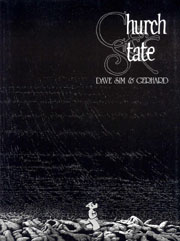
Cerebus attempts to regain his lost throne amidst warnings of a larger crisis. Mountain climbing, the introductions of Prince Mick and Prince Keef (exactly who you might think they are), the Super Secret Sacred Wars, and an Ascension mark this second half of the Church and State opus. The major plot lines, which started 10 years earlier in Cerebus and High Society, are resolved (to some degree). In the closing pages of Church and State II, a judge conveys upon Cerebus a sentence that will haunt him and the reader for the rest of Cerebus' life.

Jaka's Story brings
the love of Cerebus's life to center stage, providing insights into her
childhood and showing her current life married to Rick, while Cerebus
is essentially a supporting character. Scenes of a marital life on the
fringe of society are interspersed with the story of Cerebus as a houseguest.
This book introduces Oscar and the growing threat of the Cirinists. This
is also the first book to mix pages of art with pages of extensive text.
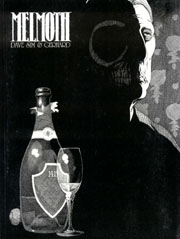
More than 11 years into a 26-year project of chronicling the life of a single main character, Dave Sim took a small detour (of sorts), put his main character Cerebus on the sidelines, and told this story of the last days of Oscar Wilde. By combining and slightly altering the very real letters of Robert Ross to More Adey (originally printed in the Collected Letters of Oscar Wilde), Sim was able to add a depth and breadth to his fiction never before possible.

The counterpoint to the impressive foundation of the two-volume, 1,200-page Church & State is the equally impressive, equally complex Mothers & Daughters, the first volume of which is Flight. This graphic novel concerns the fight between the newly established matriarchy and the opposing "daughterarchy." Cerebus, trying to regain the power he lost when the matriarchal Cirinists took over, heads down a fateful, blood-soaked path.
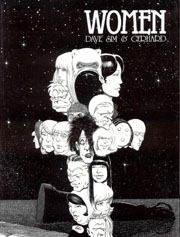
As the title implies, this is a closer examination of the matriarchy established by Cirin than we have been given before, and a closer look at the relationship between Cirin and Astoria. It also provides an in-depth look at "Cirinism" and "Kevillism," two competing religious/philosophical systems we have been hearing about since the early issues with seldom a clear idea what they meant. Cirinism is a matriarchal dictatorship and a religion worshipping "Terim," the Great Mother (as opposed to "Tarim" the God of the orthodox church Cerebus was briefly the head of). Astoria and the Kevillists also revere "Terim," but represent daughters rather than mothers - more concerned with freedom and a woman's right to choose. Kevillists can be read as Sim's critique of modern feminists, while Cirinists are more like Margaret Thatcher - who in fact shows up as a Cirinist, first in Jaka's Story and again here.

The ninth volume of the Cerebus the Aardvark series, Reads, is the penultimate chapter of the larger Mothers and Daughters story. This is one of the most powerful editions in the series and one of the most ambitious narratives that Dave Sim has ever attempted.
In addition, Reads is the most controversial volume of the Cerebus series
to date because of a parallel narrative involving two characters -- Viktor
Reid and Viktor Davis--who are both alter egos for Dave Sim. This controversy
is a shame because the "offensive" section in Reads -- which
explores the relationship between men and women -- represents only one
possible view of this subject. When read as part of the whole series,
the passages that may have seemed shocking to some, appear (like all points
of this narrative) to question and provoke rather than offend. Viktor
Davis is far from a reliable narrator, an idea that is reinforced by the
final paragraphs of his narrative and demonstrated by the scariest of
all Cerebus practical jokes. Are Viktor Davis or Viktor Reid representative
of Dave Sim or simply aspects of his persona? The ending suggests the
answer.
Meanwhile, Cerebus,
Po, Cirin, and Astoria debate the important stuff, including our aardvark
friend's genitalia, the history of Illusionism, the nature of power, and
the fate of Astoria's child. Despite the bad rap, Reads is Cerebus at
its finest. Like the best of art, Reads has the power to shock, surprise,
amuse, and offend--and it even has an incredible fight scene.
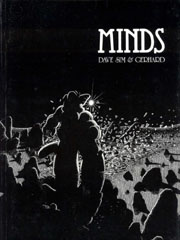
At the end of "Church & State" Cerebus went to the Moon, where he was told how the universe began and how his own world will end (and that he himself would die "alone, unloved and unmourned") by a stern Judge whose reliability has since been called into question. At the end of the final "Mothers & Daughters" volume, Cerebus takes a much longer trip, and meets his creator.
In many ways, this volume marks the end of the "story proper" as the true nature of Cerebus' world is revealed.

In this collection
of Cerebus, Dave Sim looks at life in a pub as the male patrons interact.
Lots of guest stars from previous Cerebus books appear: Mick & Keef,
Bear, and others. This book will make you think about platonic friendships
between males and their relationships with women. Shows some insight into
the Cirinist regime that has been set up and how Cerebus deals with it.
Mrs Thatcher also returns. Many laughs in this one!
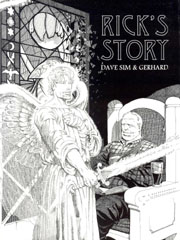
With "Rick's Story," Dave Sim and Gerhard created a chapter in the story of Cerebus that deserves a place with other respected graphic novels. The story carefully studies the two main characters, Rick and Cerebus, as they suffer a purgatory unique to each but shared by both. The episodes expose the characters' dilemmas with well-crafted storytelling and inventive graphic devices. At certain points, Cerebus struggles to subdue his growing madness by quietly arguing with the many different and distinct voices in his head. This allows Sim to show off his effective expression of dialect and tone within his drawn script. At other points, Rick slips into a martyr fantasy as expressed in friezes from stained-glass windows. As the typeset narrative continues in the margins, the windows act both as illustration and backdrop for the characters' actions.

F. Scott Fitzgerald enters the world of Cerebus--in a manner of speaking--as Cerebus begins the journey back to his birthplace in the north, accompanied by Jaka. More is revealed of Rick's place in the world of Cerebus, and the reader is given glimpses of a deeper conspiracy.
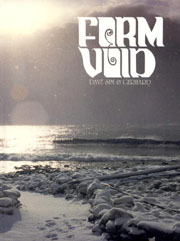
This book continues the storyline that began in "Going Home." Dave Sim turns his literary lens to Ernest Hemingway, using entries from Mary Hemingway's journal as script and inspiration. Beware. This is not the glowing review that most give 'Poppa', but a critical look at a deeply troubled writer and his equally dysfunctional wife. Dave Sim puts forth a well-documented argument to support his ideas.
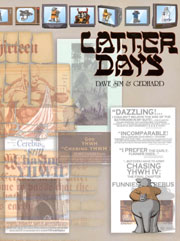
Roughly a third of this collection is given over to an exegesis of the Torah, to the effect that God and YHWH are different entities, and that the latter (whose name is transliterated as "Yoowhoo") is actually a false, female God. Sim accompanies this with an extended parody of/commentary on Woody Allen's career. A chunk of the book featuring the Three Stooges captures their body language almost miraculously, which makes a sequence about their declining years heartbreaking. This volume (much of which takes place after the entire supporting cast of the series has died, off-panel) also involves dead-on parodies of Preacher, Spawn, The Comics Journal and the Sermon on the Mount, which contains scenes of bloodshed alternately played for stomach-churning horror and for giggles. Fifty pages of Sim's notes on his work follow this.

It begins with a dream revealing the origin of the universe, and ends with the death of our protagonist. The final volume of Cerebus recounts the last day of his life, isolated in a single room for security reasons. During the course of events Cerebus is forced to deal one last time with bureaucracy, and receives a very special visitor - who presents a shocking gift!
_______________________________________________________________
(Much of this was borrowed from Amazon, CerebusFangirl, and Win-Mill - will re-write as I go along.)
Thanks to Jeff Seiler for his editorial input.